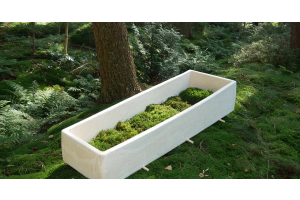
As cremation trends toward the norm across the United States, critics come out of the chemically-untreated woodwork. Cremation is an unsafe practice, they say. The act of cremation emits dangerous toxins into the environment, and consumes huge quantities of energy simply to turn one body into ashes. While some of these complaints have a small nugget of truth, the misrepresentation of information is striking. Experts claim that cremation and use of biodegradable urns are actually far more environmentally-friendly than a traditional burial, particularly when modern technologies and new approaches are used.
Classifying Cremation
When it comes to the environmental impacts of cremation, misinformation abounds. Recently, the Huffington Post discussed a number of green burial options, automatically discounting cremation because of fossil fuel consumption and mercury emissions. How much fuel is consumed, and how much mercury is emitted? More importantly, why are these sources not discussing actual quantities? The numbers vary widely, particularly relating to newer technologies used for cremation. Sources are too quick to cite or rely on old information about cremation and its environmental impact. More importantly, this criticism fails to take into consideration the most-likely alternative for Americans choosing cremation: traditional burial. Even the Green Burial Council argues that cremation and cremation urns use fewer resources than almost every other choice currently available.
Recent Improvements
Fuel efficiency is on the minds of many more people than just those in the burial industry. Almost every appliance people use in their daily lives has been redesigned to consume less energy, be it electric or fossil fuel-based. This is true for crematoriums as well. The Oregon Cremation Alliance claims that new machines can complete a cremation in as little as a third of the time it takes older machines. As an added benefit, newer equipment does not need to cool down from one cremation to the next, so they can take greater advantage of residual heat instead of merely wasting that energy or having to take steps to reclaim it.
Looking at Real Impacts
All types of burial have an environmental impact in one form or another. It is true that the standard approach to cremation by flame uses fuel, and typically a fossil fuel in the form of coal or natural gas. It is also important to note that older machines will utilize fuel less efficiently than newer components. That is the case with furnaces used to heat homes and businesses, as well. The Green Burial Council notes that traditional burial generates an enormous carbon footprint on its own through the industrial production necessary to manufacture the casket, equipment to move the casket, as well as the cement vault that most caskets are placed inside at a cemetery. Toxic chemical emission is another concern the critics like to mention. However, despite complaints about buildup of toxic exhaust downwind from crematories, the evidence shows that cremation is not causing any more serious problems than virtually any other common environmental contaminants. Mercury emissions were a primary concern in past decades, due to the mercury vapor emitted from a body that had dental amalgam fillings with mercury. The Cremation Association of North America cited a study conducted in England, where cremation is far more common than in the U.S. In that study, researchers noted that mercury levels were slightly higher downwind of crematories, but still not at statistically significant levels. The mercury threat presented to people from their consumption of swordfish is dramatically higher.
New Technologies in Cremation
Critics rely on outdated information to fuel anger against the rising rate of cremation. So, it makes sense that they generally ignore the new technologies that make cremation a more environmentally-friendly choice than ever before. Alkaline hydrolysis, also known as “green cremation,” allows for the dissolution of the body into many much smaller fragments, using a small fraction of the energy. With alkaline hydrolysis, a body is placed in a solution of water and potassium hydroxide. After the contents of the container are heated to about 350 degrees Fahrenheit, the body dissolves into a sterile liquid and bone fragments. The process takes about 2-3 hours, about the same time as a traditional cremation. The Funeral Consumers Alliance of Minnesota claims that alkaline hydrolysis: • uses 1/8 of the energy of typical cremation • decreases carbon footprint by 75 percent • prevents mercury vapor from dental amalgam Proponents say that alkaline hydrolysis may be the most environmentally-conscious ways to dispose of a body, all factors considered.
Green Burial Approaches
With the trend toward green burial, why does the Green Burial Council claim that cremation is still one of the best options for consumers concerned about environmental impacts? The answer is simple: traditional burial is still the norm, and these practices, from formaldehyde embalming to the materials used to manufacture coffins, are not friendly to the environment. The Green Burial Council advocates for standards that take environmental impacts into consideration. This includes the burial of bodies in biodegradable containers with natural embalming made from essential oils. When people choose to be cremated in a natural, fuel-efficient manner, and have their ashes placed in biodegradable urns for burial underground or in the sea, they are demonstrating a thorough commitment to the environment. Ultimately, people just want to know that when they die, their remains will be put into cremation urns or buried in such a way as to minimize environmental impacts. Critics of cremation do no one a service by spreading misinformation about the ecological effects of cremation. With the right information, families can make the best decision on burial approaches that will truly represent their loves ones’ wishes.






Have you checked out our Biodegradable Cremation and Scattering urns?
https://www.inthelighturns.com/biodegradable.html
https://www.inthelighturns.com/scattering-tubes/biodegradable.html
I hope this is helpful.
Sincerely,
Susan Fraser